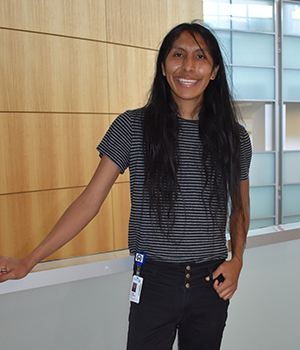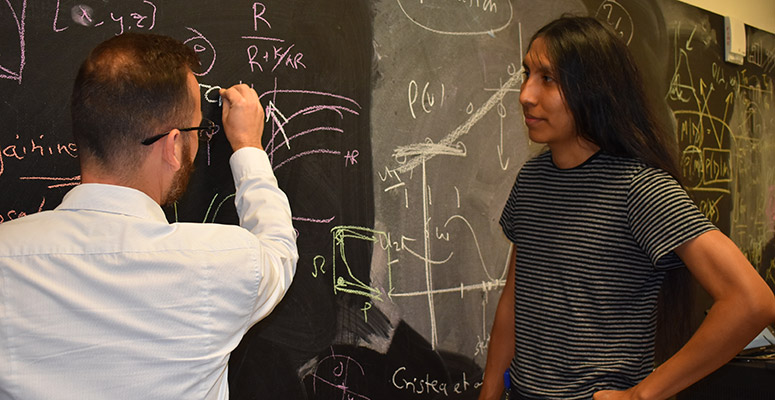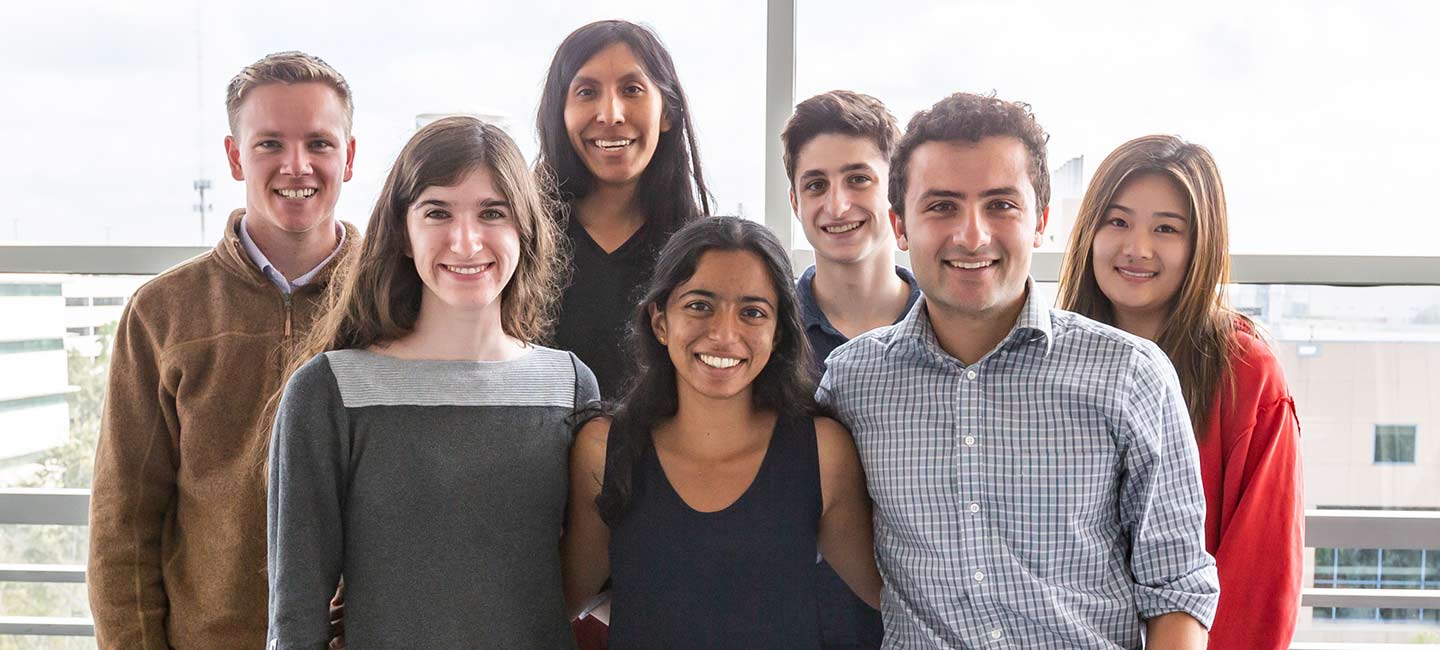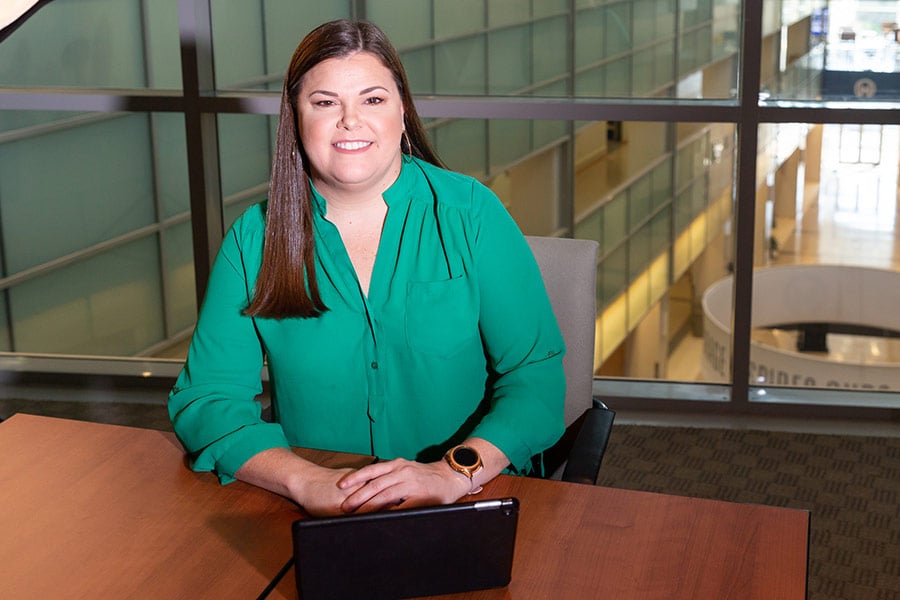Math A ‘Common Denominator’ for College Students
When you get off the elevator on the fourth floor of Moffitt Cancer Center’s Vincent A. Stabile Research Building, you’re greeted with the aroma of fresh coffee. Take a few steps into the office suite, and you’ll find a room full of chalkboards and well-caffeinated mathematicians scribbling equations everywhere. You may wonder why a cancer center would have a department full of mathematicians, but the addition of mathematical concepts and modeling to cancer research has resulted in better treatment strategies for patients.
The Integrated Mathematical Oncology (IMO) Department is comprised of biologists, physicists, mathematicians and computer modelers who work together with Moffitt’s physicians and scientists to answer some of cancer’s biggest questions, such as when cancer will metastasize or how long until patients become resistant to a specific therapy.
“Math is the universal language,” said Dr. Heiko Enderling, a mathematical biologist and director of education and outreach for the IMO. “No matter where you are in the world or who you encounter, math is a common denominator.”

Dr. Heiko Enderling and Dr. Dorothy Wallace
After joining Moffitt in 2013, Enderling knew he wanted to educate others on the importance of math and how it is used in the real world, more specifically how it can be utilized to help improve cancer research and save lives. He contacted Dr. Dorothy Wallace, a Dartmouth mathematics professor he met while attending a math conference in Rio de Janeiro in 2010. He wanted her help to develop a program where college students can come to Moffitt for a semester to learn how to combine math, biology, evolutionary principles and computer modeling for the understanding and exploration of cancer.
“It took us a while to get all the pieces in place, but we were able to develop a curriculum and get the program approved by the university,” said Wallace.
In 2018, the first class of Dartmouth math majors traveled to Tampa to learn and work with the IMO team for eight weeks. Students are at Moffitt five days a week, taking three math courses during the first half of the week and working with an assigned IMO mentor the second half. They are given a question of their own to research, model and present at the end of the program. Because certain pre-requisites are required, the program is offered only every two years. It is also capped at 10 students.
“It’s not uncommon for people to associate a career in math with being an engineer, accountant or professor. That is why we have education programs from the high school level to graduate research: to teach students that there are other ways to utilize their math skills, such as biology and life science,” said Enderling.

Ty Fierce Metteba, Dartmouth Student
“It was a bit overwhelming at first. But I would say the simplest kind of math that I’ve been able to understand as it relates to cancer research is the logistic growth equation, like population dynamics,” said Ty Fierce Metteba, a student who is part of the second cohort in the Dartmouth-Moffitt program.
Metteba has a unique tie to math. He is a member of the Navajo Indian tribe, the same tribe that enabled the Navajo Code Talkers to decode, encode and transmit messages for U.S. Marines during WWII. For Metteba, the implementation of math is not only a necessity, but also a skill that has come easier to him than other subjects. And he enjoys learning how it can be put to good use in health care, which is an area he says he may explore for a career after college.
For now, he is using the lessons he’s learned while at Moffitt to possibly help head and neck cancer patients in the future. “We want to see if we can predict how patients respond to radiotherapy. And if so, for whom do we need to bump up the frequency and/or dose, and for whom can we reduce treatment?” he said.
Metteba and his classmates are using computer models, referred to as in silico, which can simulate large scale experiments without imposing real world damage. “It’s fun to see how we can use in silico models to simulate all of these otherwise expensive wet lab scenarios. We can do it hundreds and thousands of times and get more accurate results. That, I think is just incredible,” Metteba added. “We can make as many mistakes until we get it right and no one dies, that’s the best part about math.”

Dr. Heiko Enderling discusses a math model with Dartmouth student Ty Fierce Metteba
The IMO team’s dedication to education doesn’t stop with college students. The department also has a summer program for high school students called HIP-IMO, or High School Internship Program in Integrated Mathematical Oncology. Now in its sixth year, the eight-week program is offered to high school juniors and seniors, and has attracted students from across the U.S. The teens’ curriculum mimics the Dartmouth program, teaching the students everything from cancer biology to computer programming.
“We want our educational programs to serve as a gateway into a science career,” said Enderling. “It’s an opportunity to spark a little light and see them run with it.”



